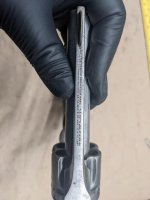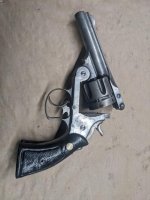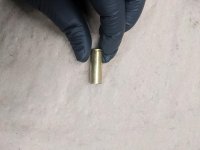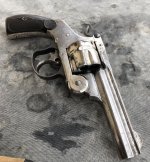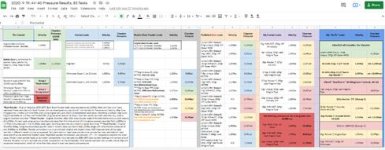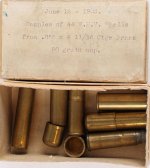Before I start I want to tell the OP I was not referring to his original post, I replied directly to glowe's post and replying again directly to glowe's reply to me.
Also, in respect to the OP's topic, I will no longer reply to this topic unless I have something to contribute that directly relates the the revolver at hand.
glowe, I am more than happy to continue after this reply in a private message.
Are you the author of this article or had input into the article?
Obviously once again you are not reading the information or you would know. It is more than an article, it is an entire website.
Too bad you can quickly dismiss other opinions and do it in a very rude and condescending manner!
It is not about dismissing other's opinions, it is about posting correct information. A black bird is black, but if it your opinion that it is pink, then I guess it is pink.
If this is your response to someone that does not agree with something linked in a post you did not even author and are doing so with no regard or interest in what others might know, it is not worth my time to refute just about every copy and paste reply you could find.
What dose it matter if I did or did not author the information? Would you believe me if I did? Copy and paste?, you obviously again are not reading the material thus justifying your lack of interest to refute, of which you are doing anyway.
The article is a nice timeline and history of the caliber, but has little to do with today's reloading or antique revolver shooting.
Again, you refuse to read all of the information at hand and it has everything to do with today's reloading and related antique firearms.
https://sites.google.com/view/44winchester/chasing-the-44-40/handloading
I can find only couple references made to revolvers and all the information contained in this entire article is for rifles.
again, dig deeper, I can not copy and paste the entire website's contents just for your convenience.
The OP is not asking about rifle shooting and ammo development.
I was not replying to the OP, I replied to your reply to someone else's reply.
Have you extensively studied this caliber?
Yes, I have and am still a student of this cartridge. The cartridge is available in more than one caliber ranging from .424" to about .432' depending on the shooter's needs.
Have you done years worth of research with black powder conversions to smokeless? Do you have lots of revolvers and rifles you have tested 44-40 loads in? I do and did.
yes, I have
There is little information actually supplied from the author's research in that article and nothing that relates to antique revolver shooting, just lots of work done by others copied and pasted. Yes, I read it and my conclusion is that if I were to try to use that information to properly make comparisons between BP and smokeless for revolvers, it would be impossible to do.
We already covered that area....you failed to read the website's information and the contributor's therein
As for your claim that there is no high velocity 44-40 loaded today and was also loaded a hundred years ago.
Did you just seriously say that? Proof you failed to read my previous reply to you.
Here is the main page link again...at least try and read it.
https://sites.google.com/view/44winchester/chasing-the-44-40
Here is Buffalo Bores 44-40 "Heavy" information...try to read all of the information.
Heavy 44-40 (44WCF) Pistol & Handgun Ammunition You will actually have to go look for the ammo page. Lets see what snips I can find about it....oh wait, I actually have Buffalo Bore's permission to add the entire information to the 44-40 website here: Chasing the 44-40 - Buffalo Bore, Target #181 With that, I will add some snips for your convenience.
Item # 44-40 200 HC, features a 15 BHN hard cast bullet. (Pure lead is 4-5 BHN) This bullet will not expand when impacting living mammalian tissues at 1,300 fps or less. It will act as a "solid" and therefore penetrate quite deeply (at least three feet+, depending on what bones are struck). The flat nose will do a great deal of terminal damage when compared to a round nose bullet.
The bullet is sized .428 inch and fits wonderfully into .427 through .429 bores.
We are also using a flash suppressed powder to avoid blinding muzzle flash in the event you are forced to drop the hammer in low light when the criminal element and when wild animals are most active.
We do not intend to make a jacketed bullet load in 44-40 as jacketed bullets, in general, are not as slick as hard cast bullets and raise pressures far too much.
We would have to load a jacketed bullet about 200-250 fps slower than a hard cast bullet to stay within the SAAMI max. average pressure spec. of 13,000 CUP.
➤ 1,350 fps -- Winchester model 1892, 20-inch barrel, circa 1916
➤ 1,353 fps -- Uberti model 1873, 19-inch barrel, circa 1997
➤ 1,034 fps -- Ruger Vaquero (large frame), 7.5-inch barrel, circa 2003
➤ 1,036 fps -- Colt New Service, 7.5-inch barrel, circa 1905
➤ 980 fps -- S&W model 544, 5.5-inch barrel, circa 1980's
➤ 1,080 fps -- Custom (Brian Pearce made) SAA replica, 5.5-inch barrel, circa 2017 - Not A Typo
➤ 949 fps -- Ruger converted 357 Mag. flat top (by Jack Huntington), circa 1959, 4.75-inch barrel
There is nothing "High Velocity" about the 44-40 "Heavy" by Buffalo Bore.
Buffalo Bore loads a Heavy 44-40 that I would never shoot in a revolver or even a Winchester toggle rifle.
Why, do you fail to trust a well known and reputable ammunition manufacture?
The ammunition currently available is high velocity for both solid frame revolvers and rifles.
Buffalo says otherwise right on the website. This is not HV loads and the warning is for use in vintage firearms for obvious liability reason. No one in their right mind will ever tell anyone to shoot any ammunition in a vintage firearms, only the shooter can decide what he or she wants to do.
Velocities run as high as 1170 fps in a revolver and 1470 fps in a rifle.
Where in Buffalo Bore's data do you find such bogus information?
This ammunition has no place in a S&W top-break revolver.
Buffalo Bore warns against it but again, that is an example of an opinion, not fact....even I do not suggest such activities.
High Velocity 44-40 ammo has been available since the invention of smokeless powder and are also nothing I would shoot in an old S&W.
I never said anyone should. The following attached photos are of the 44 Winchester High Velocity Draw Set dated 1903 is in my collection
Chasing the 44-40 - Understanding Winchester's 44-40 High Velocity Loads It would be a wise thing to actually go read about it! I also have other 44-40 ammunition items in my collection of which some can be seen here: https://docs.google.com/spreadsheet...cnEM1lv6tCWBJsCOB8vLIDOIg/edit#gid=1905899731
The author of your favorite article clearly lists a High Velocity Winchester rifle smokeless loading of 44-40 with pressures of 18,000 CUP in 1917 and 22,000 CUP. NEVER shoot hot loads in a 44-40 S&W. Lastly, a full 40 grain load of BP is also something I would never shoot in an antique revolver. It is a fierce round and felt recoil is very high and can dislodge these round butt revolver right out of your hand.
Again you venture to a place I did not go. I never said you should. If you go back and read what I wrote in my original reply to you, I stated that they were only for Strong Action rifles. Manufactured specifically for Winchester's Model 1892 rifle. If you go look at Lyman's 49th, you will also notice Lyman lists 19 rifles chamber for the 44-40 of which 9 are strong action "Group II" rifles. Here, I will add yet another link for you to the same website including some SAAMI specs and Lyman's information. https://sites.google.com/view/44winchester/chasing-the-44-40/handloading/ansisaami-specs
The key to loading vintage revolvers today is to keep pressures and velocities well below that of original BP loads which are often quoted averaging 13,000 psi to 15,000 psi.
No, the key...and this is an example of my opinion...remember...we all have one?.......is making sure the vintage revolver is in a condition safe enough to shoot, regardless of suggested pressures it is to be exposed to.....and no sane gunsmith should ever tell you that one is safe...maybe should be safe based on his examination but unless he x-rays the material....nope!!!
I am sure you do not care about the fact that this whole tirade of yours involves nothing more than knowing a handful of numbers to be safe out there when shooting antique guns, but maybe someone else in interested.
Oh really, you don't even know me...how can you be sure? Where is the due process?
They will not get that simple data from the article you posted.
Correct, they need to read the entire website!!!
Reloading is about matching bullet selection, velocity and max pressure of the original round and then working even lower.
That is why there is reloading manuals and is why I based parts of my pressure testing from such load data published. You obviously have not reviewed those either. I posted links in previous reply.
There is a safe level and and that is determined by knowing what original pressures and velocities were obtained by black powder in those calibers that started out in the 1800s.
Correct, and was included in the test result information, again...previously provided.
As for what I load and shoot, knowing that original BP load pressures have been posted for years and will almost always fall near 13,000 CUP using a 200 grain lead bullet, pushed at just over 1,000 fps in a rifle.
Then you have been ill informed...again, information link previously posted right from Winchester's 1875 catalogue
There are many smokeless powders available and full load data tables that show pressures of various loads, not all powder reloading sites list 44-40 revolver loads.
No need to preach to the choir....I have already shared such information.
Hodgdons is a good site for reloading this caliber at pressures as much as 50% lower than original BP and no one can dispute they are much safer in antique revolvers than BP. A couple of old standbys and one newer entry into the market show some great loads and are the way to go for 44 Frontiers. 700X, Clays, and Trail Boss all supply low pressure reloads for 200 grain lead bullets.
I could post a whole nother page on this subject alone....smokeless powder pressure curves vs black powder pressure curves. The .427" is a caliber, the 44-40 is a cartridge.
700X with 5.0g powder runs 788fps at only 7,100 CUP
Clays with 4.2g powder runs 648fps at 8,200 PSI
Trail Boss with 5.5g powder runs 723fps at 7,800 PSI
These pressures are in line with Winchester's Super-X 44-40 hunting loads and higher than Winchester's low recoil cowboy action loads. All of those loads are safe for any firearm in "safe operational condition". The catch is how is any firearm deemed "safe" to operate? Some are obvious, some are not.
Personally, I load to 700 fps so pressures are even lower, but there is no argument that the proper use of smokeless powder can always be safer for antique S&Ws than full load BP.
Hard to disagree with that one ;-)
